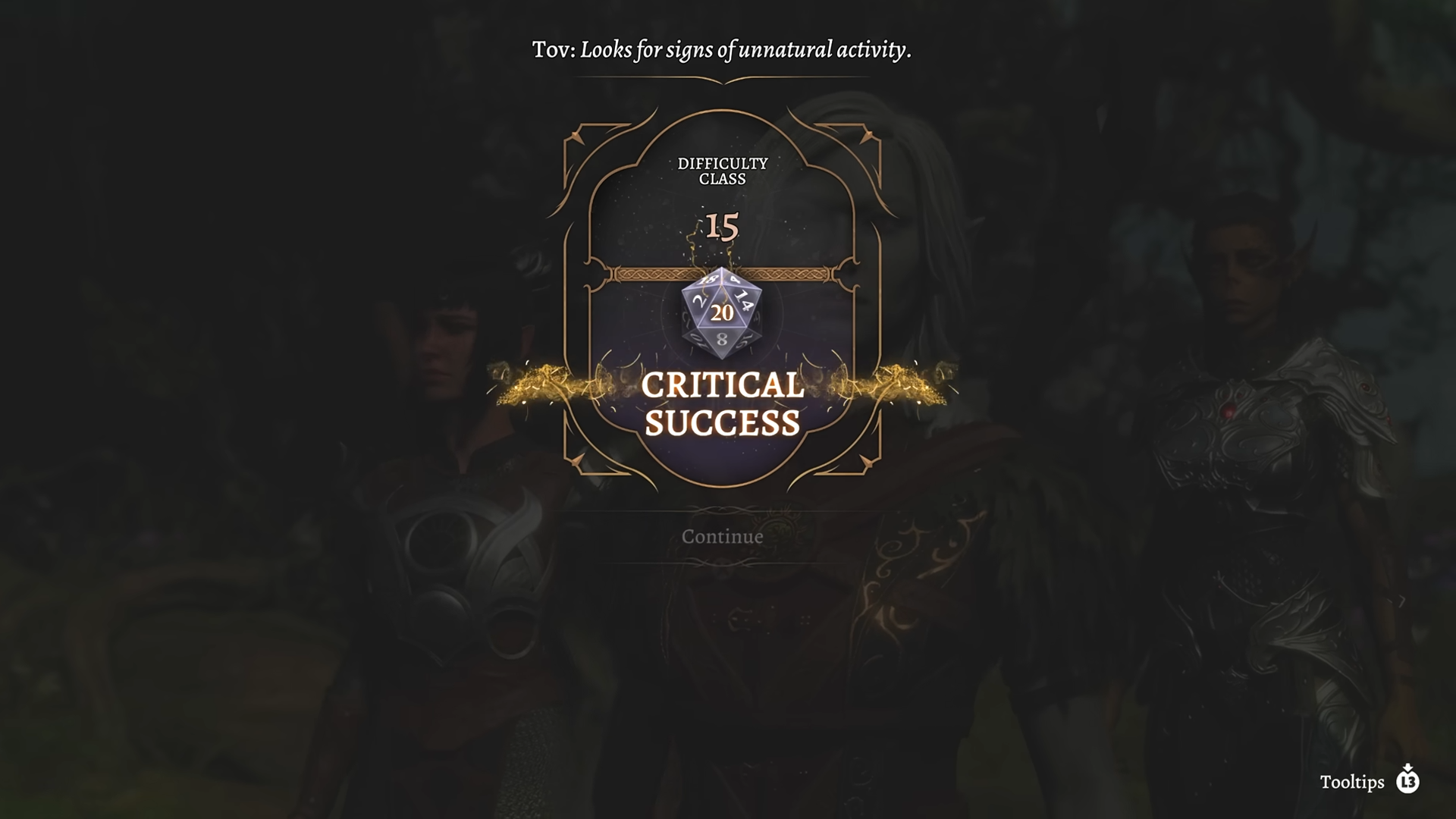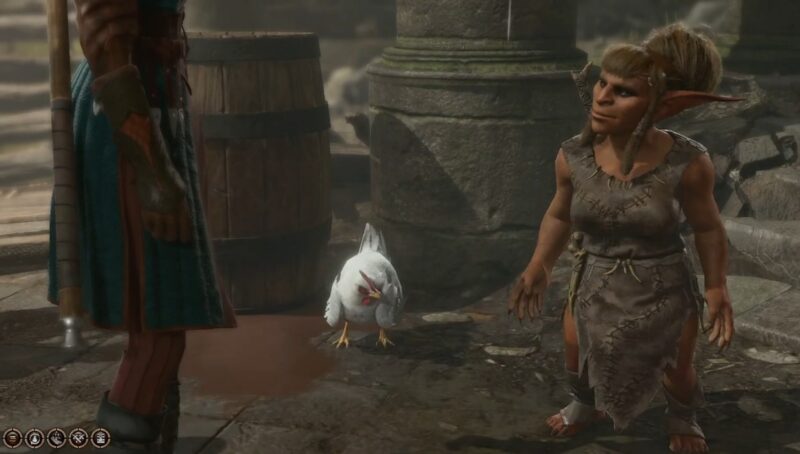Our Honour Mode guide shares tips for Legendary Action, Honour Mode Build, and beating Baldur’s Gate 3 on the hardest difficulty, permadeath, with only one save.

Honour Mode arrived as part of Patch 5 and introduced a new difficulty setting. This new mode presents a formidable challenge for players seeking to test their strategic prowess and adaptability. Unlike Tactician mode, Honour Mode introduces a single-save constraint, meaning that a complete party wipeout spells the end of your campaign. Our Baldur’s Gate 3 Honour Mode Guide article explains how to beat the hardest difficulty in BG3.
This build has been updated for the Patch 8 version of Baldur’s Gate 3.
How Honour Mode Works in BG3?

In Baldur’s Gate 3, you will choose the level of difficulty at the very start of the game, and Honour Mode will be the highest and hardest level of difficulty that you can select. Moreover, once you choose Honour mode and start the game you lock yourself into this setting. You can no longer change the difficulty.
Furthermore, Honour mode in Baldur’s Gate 3 is a single save slot game. This means that if your full party dies in the game, then that is a complete game over. You will not be allowed to restart from your original save file. If you want to try an Honour mode run again, then you will need to start an entire new playthrough.
What is Honour Mode in Baldur’s Gate 3

Honor Mode is the highest difficulty in Baldur’s Gate 3, which allows only one save slot, and permadeath if your entire party dies. Larian Studios added Honour Mode in Patch 5, and with it several unique features:
Single Save: Your Honor Mode campaign is bound to a single save slot that is constantly overwritten. Once a decision is made, there’s no turning back. Every action, every encounter, every outcome carries the weight of permanence.
Party Permadeath: Should your entire party fall in combat; your Honor Mode campaign comes to an end. A stat summary will commemorate your progress, but the campaign itself is over. You can choose to continue your adventure in Baldur’s Gate 3’s Custom Mode, but this will not count as an Honor Mode completion.
Legendary Actions for Bosses: Bosses in Baldur’s Gate 3 added Legendary Actions, mirroring their counterparts in Dungeons & Dragons (D&D). These extra actions can be triggered at the end of each player’s turn, adding devastating attacks to bosses.
Rewards: Beating Honour Mode will award you an in-game Golden D20 skin and a new Foehammer Achievement.

Tactician Rules: Honor Mode builds upon the foundation of Tactician difficulty. Outside of the boss fights, most of the encounters will feel familiar and difficult to the Tactician. You will also have the increased long rest cost of 80 supplies rather than 40.
In summary, Honour Mode feels like a Tactician outside of boss difficulty. The boss’s difficulty is radically different, however with legendary actions. Let us explain them first before we share combat tips in our Baldur’s Gate 3 Honour Mode Guide.
Legendary Actions
Legendary Actions are a once-per-round passive feature that can be used every round in combat. The first introduction to Legendary Actions is the Owlbear Boss in Act 1. By default, this Owlbear has 118 health and a new ability called Legendary Action Call Consort.
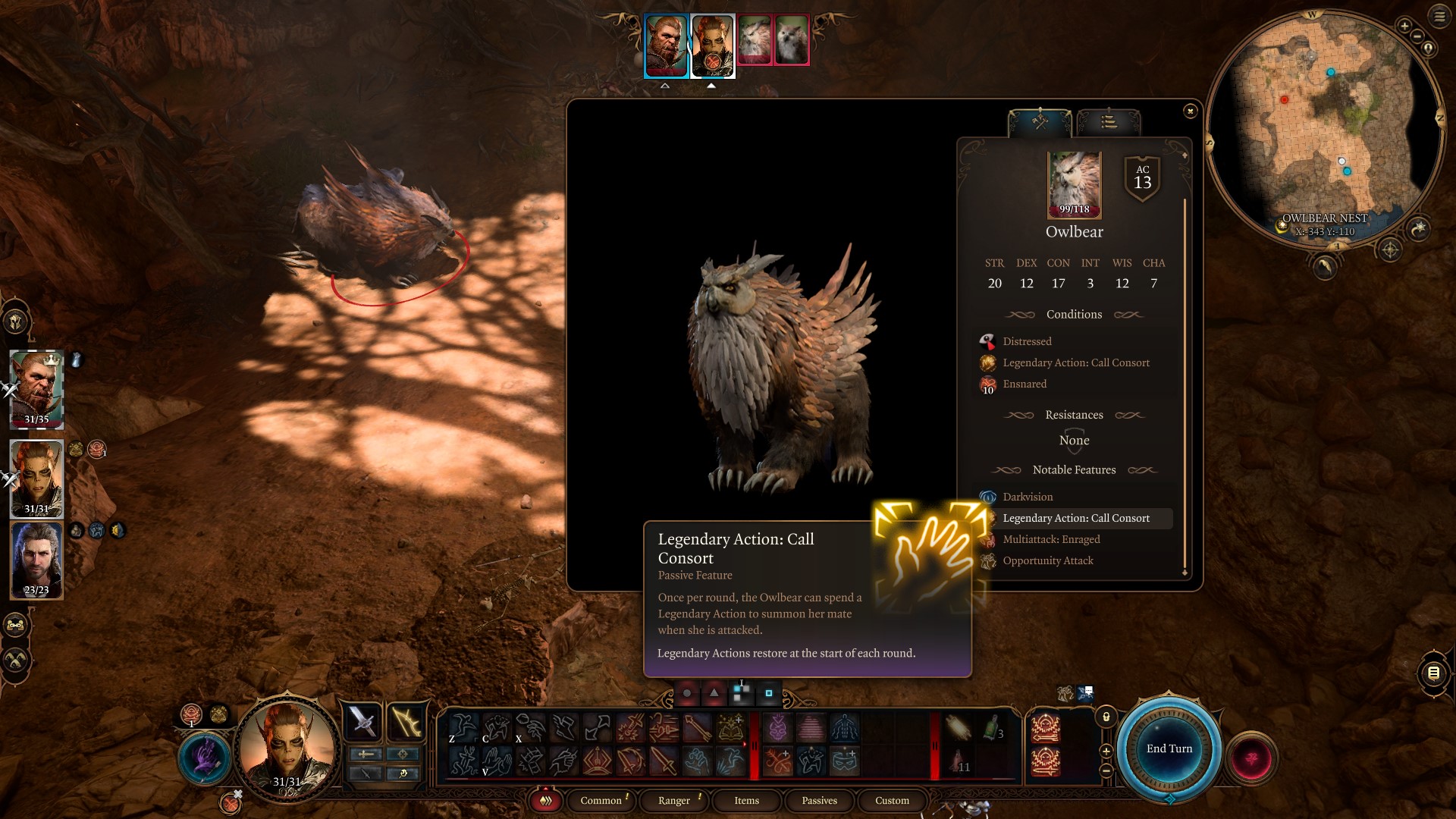
The Call Consort Legendary Action can be spent to summon her mate when she (Owlbear) is attacked. This triggers a secondary 118 HP Owlbear to appear, making the fight nearly impossible to complete at lower levels. Moreover, this can be done every combat round and is a passive feature. Consider Legendary Actions a separate resource from Actions or Reactions and replenish every turn.
Also Check:- BG3 Interactive Map
In this example, the trigger or mechanism for the ability to apply is being attacked. There’s essentially no way to avoid this during the Owlbear fight and you will have to rely on stuns and prone status effects to subdue both the Owlbear and Mate. However, at the start of every fight you can examine the character to determine the Legendary Action and the trigger. Some triggers or conditions might not be met simply by attacking, so make sure to examine every boss!
Flee from Combat
Having beat Tactician and never having a group wipe, I was disappointed when the Owlbear summoned a companion with 118 health. Quickly I became overwhelmed and had 3 allies dead on turn 1, with only my Lae’zel Gloom Stalker Ranger alive. Feeling my panic of losing hours of work in Act 1, I discovered fleeing from combat and it’s worth explaining in this Baldur’s Gate 3 Honour Mode Guide.

A flee from combat allows you to retreat to your camp at a certain distance away from enemies. This allows you to prevent a group wipe and wrecking your campaign. Early on, the game is very difficult because you lack the means to escape. However, you can keep one invisibility potion on your highest survivability character. In this example, it’s Lae’zel as a Gloom Stalker Ranger build. I consumed this, remained invisible, and fled about 30 meters from the nearest enemy. The bottom right red dot appears, and I could retreat to my camp. While a humbling experience, this might happen to you on your Honour Mode campaign, and you should familiarize yourself with the Flee from Combat function. At camp, you can spend gold to resurrect allies via Withers, which enables you to continue in the campaign.
Starter Guide Honour Mode
The best strategy for Honour Mode is to reach level 5 by collecting all gear and consumables and avoiding Honour Mode boss fights. At level 5, most martial classes gain extra attack with spellcasters gaining level 3 spells, this makes a massive difference in your overall power, thus a good start helps wiping a campaign 5 hours in. Lae’zel as a Fighter, and Karlach as a Barbarian, are my go-to when creating a powerful team that doesn’t have too frequently long rest.
10 Tips for Honour Mode
Your best tips for Honour Mode are unlocking withers, respecing your companions, and reaching level 5 ASAP. Below are 10 tips for starting and completing your Honour Mode Campaign in Baldur’s Gate 3:
- Progression: Finish the prologue, unlock companions, then head to Hollowed City.
- Druid Grove: Interact with everyone, loot everything, and sell to stock up on potions, arrows, and alchemy materials.
- Unlock Withers: At this stage, move to unlock Withers in a nearby Chapel (X:287, Y:332).
- Respec: Reroll the companions to proper ability scores, classes, and subclasses.
- Best Early Builds: Gloom Stalker Ranger, Battle Master Fighter, and Berserker Barbarian are powerful early and at level 5 gain Extra Attack.
- Reach Level 5: Engage in easy quests while exploring and avoiding bosses, and Githyanki fights until level 5 or higher.
- Optimize: Craft Potion of Speed, Drow Poison, Elixir of Bloodlust, and Hill Giant Strength, and optimize your party composition to include damage, crowd control, and healing.
- Re-Engage Bosses: At levels 5-6, you can now engage in the harder fights without dying immediately.
- Potion of Invisibility: Stockpile invisibility potions and keep 1 on each character to prevent a group wipe.
- Loot Everything: Gold is precious at the beginning, take and sell everything to upgrade gear and consumable collection.
If you make it beyond level 5, you should feel much more powerful, especially with spellcasting. Progress through the story and engage previous bosses that were too powerful. Moreover, explore the Underdark and Grymforge and acquire powerful Act 1 items before moving on to Act 2. Let us transition into combat tips and builds for the remainder of the Baldur’s Gate 3 Honour Mode Guide.
Advanced Combat Tips
In Honour Mode, your priority is combat power and understanding the core mechanics of Baldur’s Gate 3. In this guide, we will briefly go over the most important aspects of combat, and how you can use them to advance through the hardest difficulty in the game.
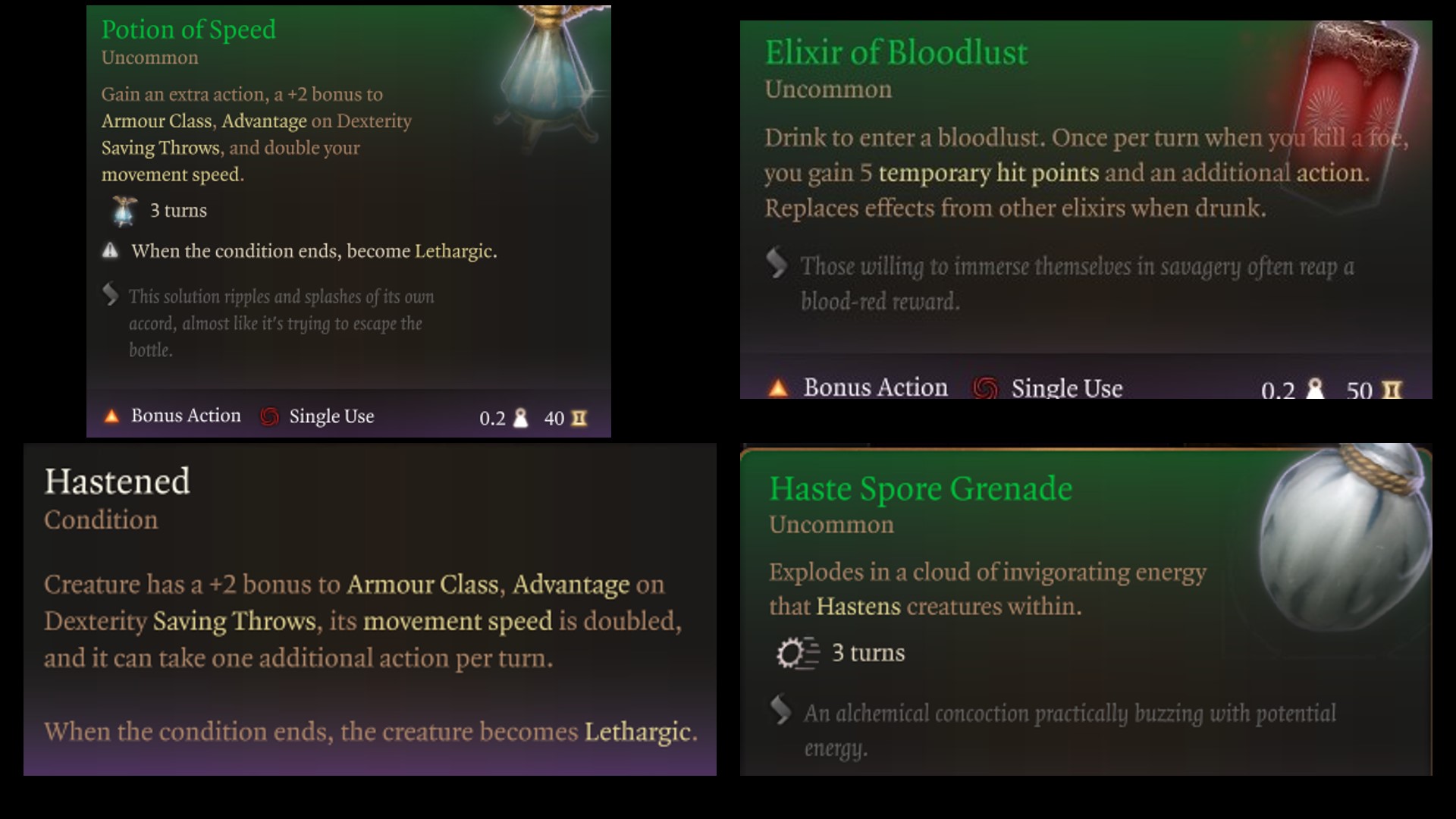
Actions
The simplest way to increase your combat in Baldur’s Gate 3 is through additional Actions. The easiest way to increase your actions is through consumables like Potion of Speed and Elixir of Bloodlust. Elixir lasts until long rest and can be applied outside of combat. At the same time, potions have a limited duration and are typically consumed in combat.
When anticipating boss fights, have your primary damage dealers consume Elixir of Bloodlust, Viciousness, or Hill Giant Strength. Once you enter combat, have your number one damage dealer consume Potion of Speed on turn one. Upon a kill, Elixir of Bloodlust will trigger an additional action, which stacks with Potion of Speed for at least 3 actions on turn one. Once you reach level 5, some classes like Ranger, Fighter, Barbarian, and Paladin have Extra Attack features. This gives them 2 attacks per 1 action. Thus, you will get at least 6 attacks on turn one, likely causing serious damage.
In summary, collect as many potions and elixirs as possible and use them frequently. Buy Worg Fang and Hyena Ear at every vendor so you can make these potions and limit long rest to keep Elixir of Bloodlust active.
Consumables

While we’ve mentioned consumables briefly, consider Oils and Toxins another powerful tool to use in Honour Mode. Poisons can be applied to weapons inside or outside of combat and last for 10 turns. Thus, you can enter stealth, activate turn base mode, and apply an oil like Drow Poisons. You can then sneak up to a target, engage in an attack, and still have 9 turns remaining on your oil. Oils stack on top of Elixirs, which will stack on top of potions. So, that gives you three powerful tools to radically increase damage though it does take some preparation.
Additionally, Ammunition like Arrows of Ice and Many Targets are vital for range weapon users. Ice Arrow in particular acts as a useful stun early because it can knock targets prone. Moreover, Arrows of Many Targets hit multiple enemies adding more damage in multiple enemy fights. Collect and use these during each encounter because Honour Mode can be brutal!
Pre-Buff
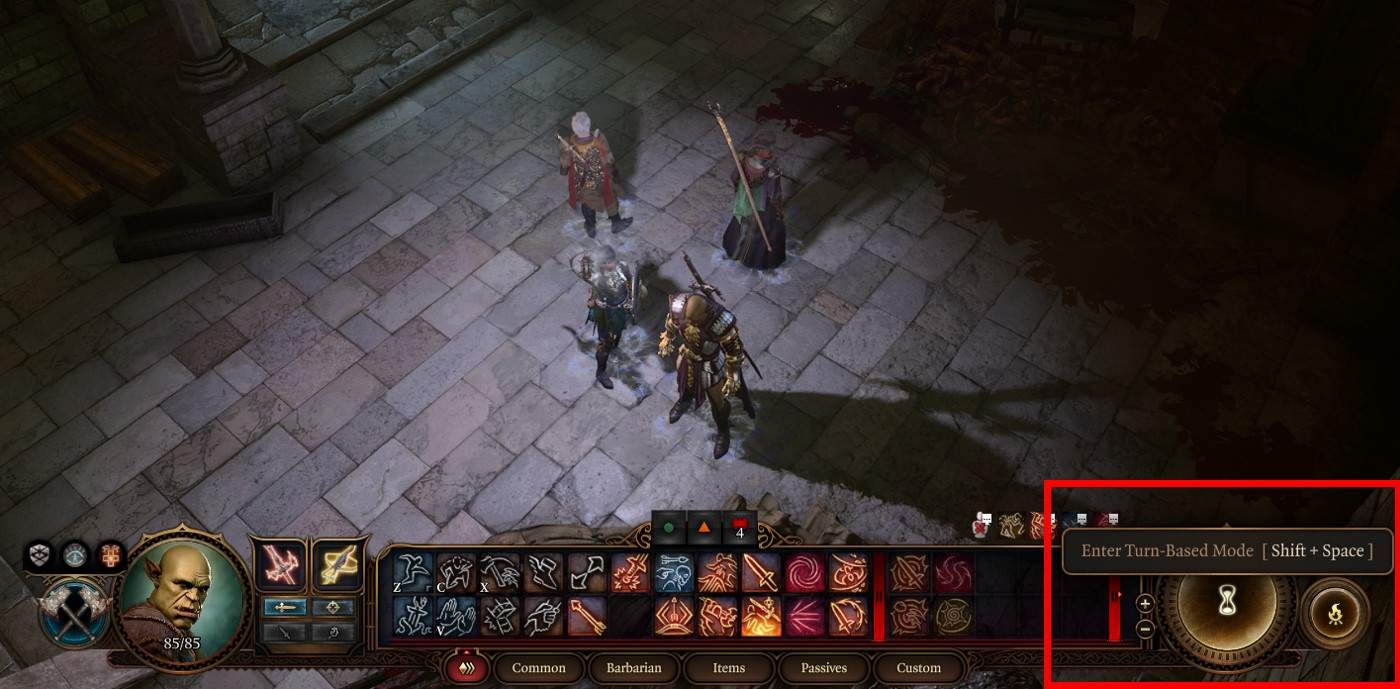
Before Honour Mode combat, you should pre-buff spells, consumables, buffs, and oils before engaging. For instance, you want to initiate turn-based combat to give yourself time to apply buffs. This will also prevent buffs or spells with limited duration from elapsing. Go through a cycle applying spells like Blessed, Shield of Faith, Freedom of Movement, etc. Then, apply oils, or potions for a long duration like Flight. Moreover, you can have one companion that specializes in “until long rest buffs.” Cast these, dismiss the companion, and bring someone else into combat. This works well at the max level with the Heroes’ Feast spell on a Druid.
Next, try to initiate combat without a dialogue popup. This can trigger the Surprise status effect. That status effect essentially skips any enemy’s turn that is struck with it. When surprised, your party will get one complete round of damage before enemies take a turn. While not all dialogue can be avoided, pick your spots, and get into the habit of pre-buff cycling to get the most out of your builds.
Crowd Control
One of the most important aspects of BG3 combat is Crowd Control (CC) or Stuns. While the game has a variety of status effects, the most common and effective is Prone. Shadowheart and Clerics get one of the most powerful early, Command. The Command spell can be specified to either knock prone with grovel or drop a weapon. What makes Command so powerful is its high chance of landing (60% or higher). Command acts as your single target shutdown early in the game and can still be used later.
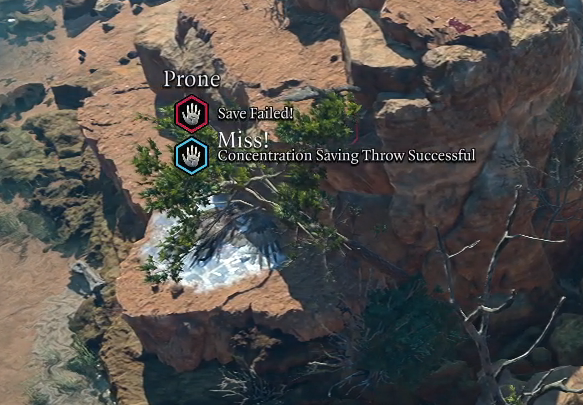
Look for other CC and stuns like Hold Person, Confusion, Banishment, Chromatic Orb Ice, Thunderous Smite, Ice Arrows, Grease, and Tasha’s Hideous Laughter. Moreover, you can find scrolls on random bookshelves or from vendors that have powerful stunning spells. Consider using these spells on classes and builds that lack innate control and target the enemy’s highest damage dealer on turn one. Let us move on to multiclassing and build specific information within the Baldur’s Gate 3 Honour Mode Guide.
Multiclassing
In Honour Mode, Multiclassing is essential to gain the most powerful build and character. The two most common and useful multiclassing classes are Rogue with Thief subclass, and the Fighter with Battle Master subclass. We have a detailed guide on this topic here, but these classes add a bonus action or action and are preferred for combat-based builds.
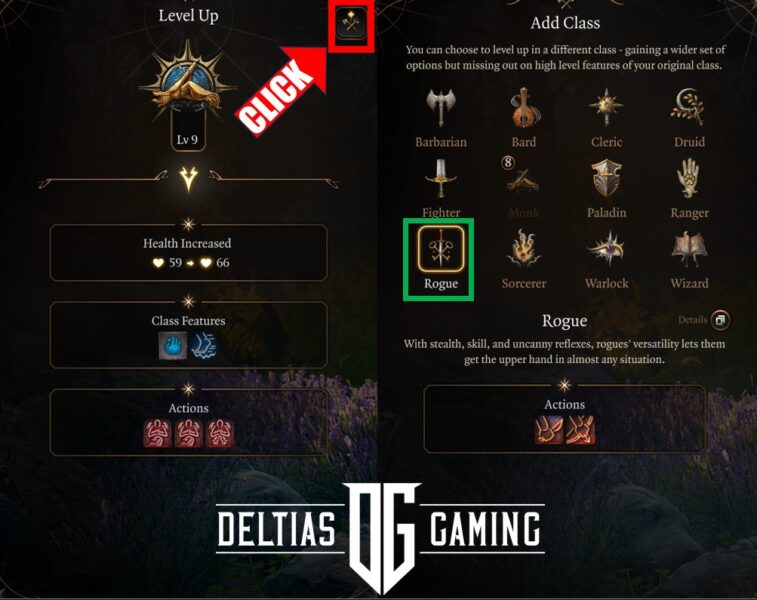
The Rogue with Thief Subclass provides the Fast Hand subclass feature with a 3-level investment. Rouge/Thief will unlock an additional bonus action per round for your character and is vital for potions, consumables, and movement functions. Additionally, the Fighter has Action Surge with only a 2-level investment. Action surge gives an additional Action once per combat. A common strategy is to take 5 levels of a class with Extra Attack, 4 levels with Rogue and Thief, and the 3 levels with Fighter and Battle Master. Check out our builds page for specifics.
Best Honour Mode Builds

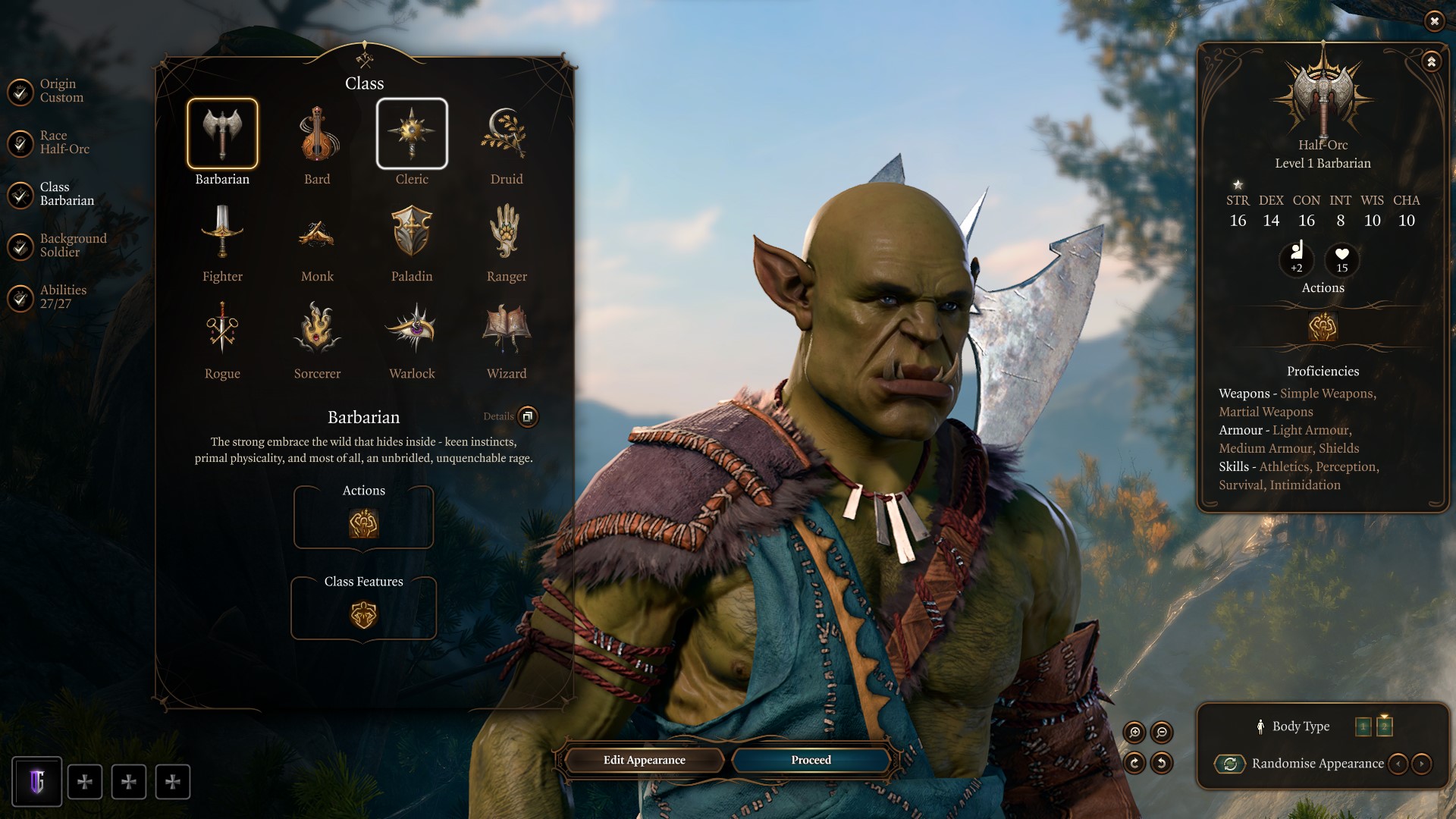
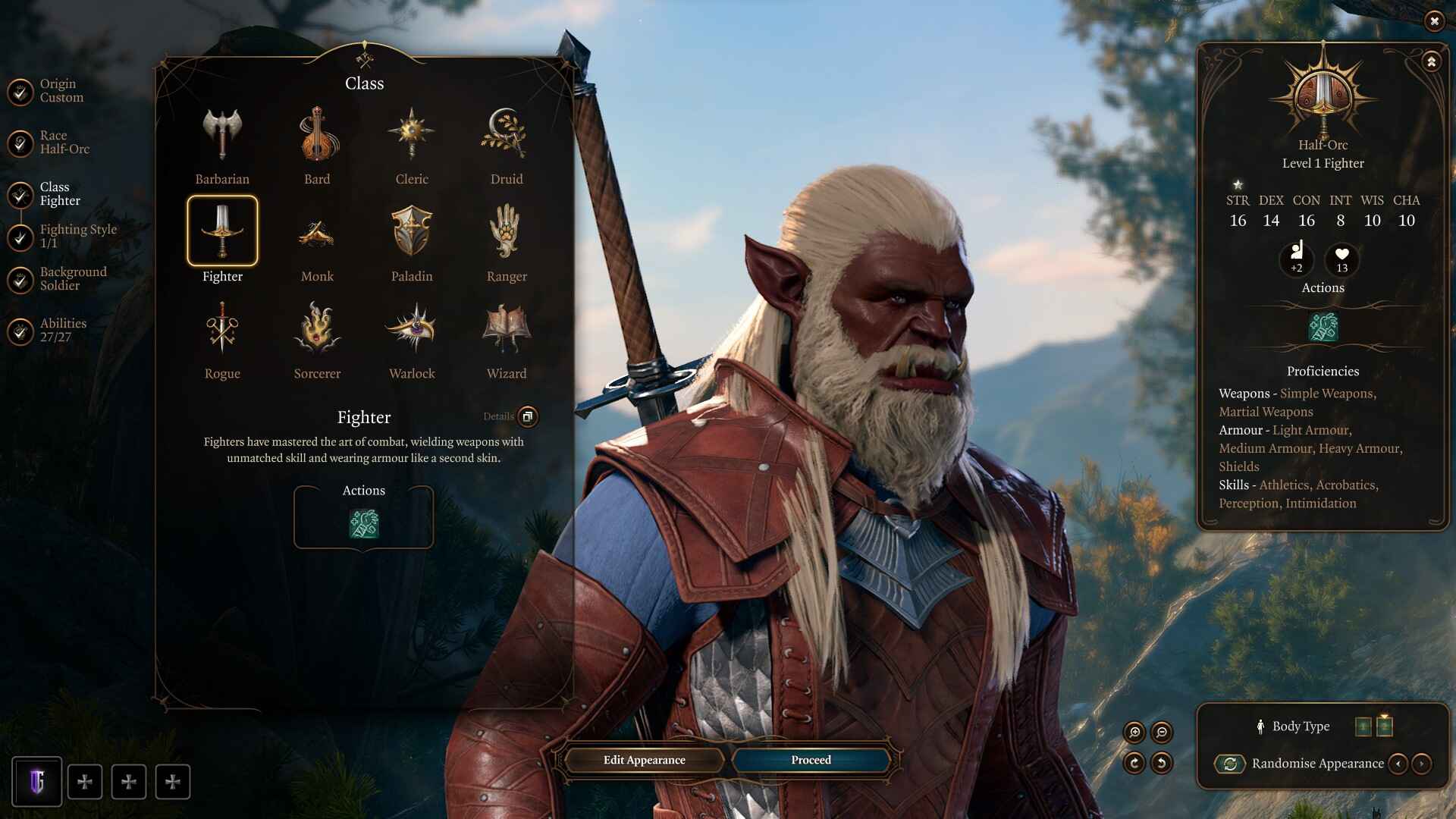
The best Honour Mode builds are the Gloom Stalker Ranger, Berserker Barbarian, and Battle Master Fighter. Each class has high survivability, range and melee combat and Extra Attack. Each of these solo builds can complete Tactician difficulty solo, and when combined, has a powerful party composition. The ability to take extra actions and attacks makes a build powerful in BG3.
For instance, a Wizard can only cast one spell with an action. However, the Sorcerer can use Quickened Magic and cast an additional spell with a bonus action. This gives the Sorcerer double the combat power in certain situations because they can simply cast more spells per round. The downside of the Sorcerer is it has limited spell selection. However, when it comes to combat, the sheer power of two Fireballs on turn one as early as level 5, makes it powerful.
Below are build templates for Honour Mode Difficulty in Baldur’s Gate 3:
Honour Mode Ranger

The Ranger Honour Mode build emphasis range damage with high initiative and survivability through invisibility. Below is a sample template of the Honour Mode Ranger:
- Class: Ranger
- Subclass: Gloom Stalker
- Primary Weapon: Longbow (Titanstring Bow & Gontr Mael)
- Secondary: One-hand and Shield (Blood of Lathander & Viconia’s Walking Fortress)
- Armor: Medium (Armor of Agility)
- Focus: Range damage with Arrow Ammunition
- Consumable: Elixir of Bloodlust or Elixir of Viciousness
- Key Features: Extra Attack, Spellcasting, Invisibility
- Multiclass: 5 Ranger, 4 Rogue, 3 Fighter
Built for ranged combat, you will rely on ammunition areas for multi-kills and crowd control. This is your primary survivability character who has high initiative and is likely to go first. This is helpful to apply pressure and CC to the most damage-producing enemy. Moreover, this character can “bail” when allies are dead and it’s unlikely to win the fighter. Always keep the invisibility potion on this character as a panic button when things get tough.
Honour Mode Barbarian
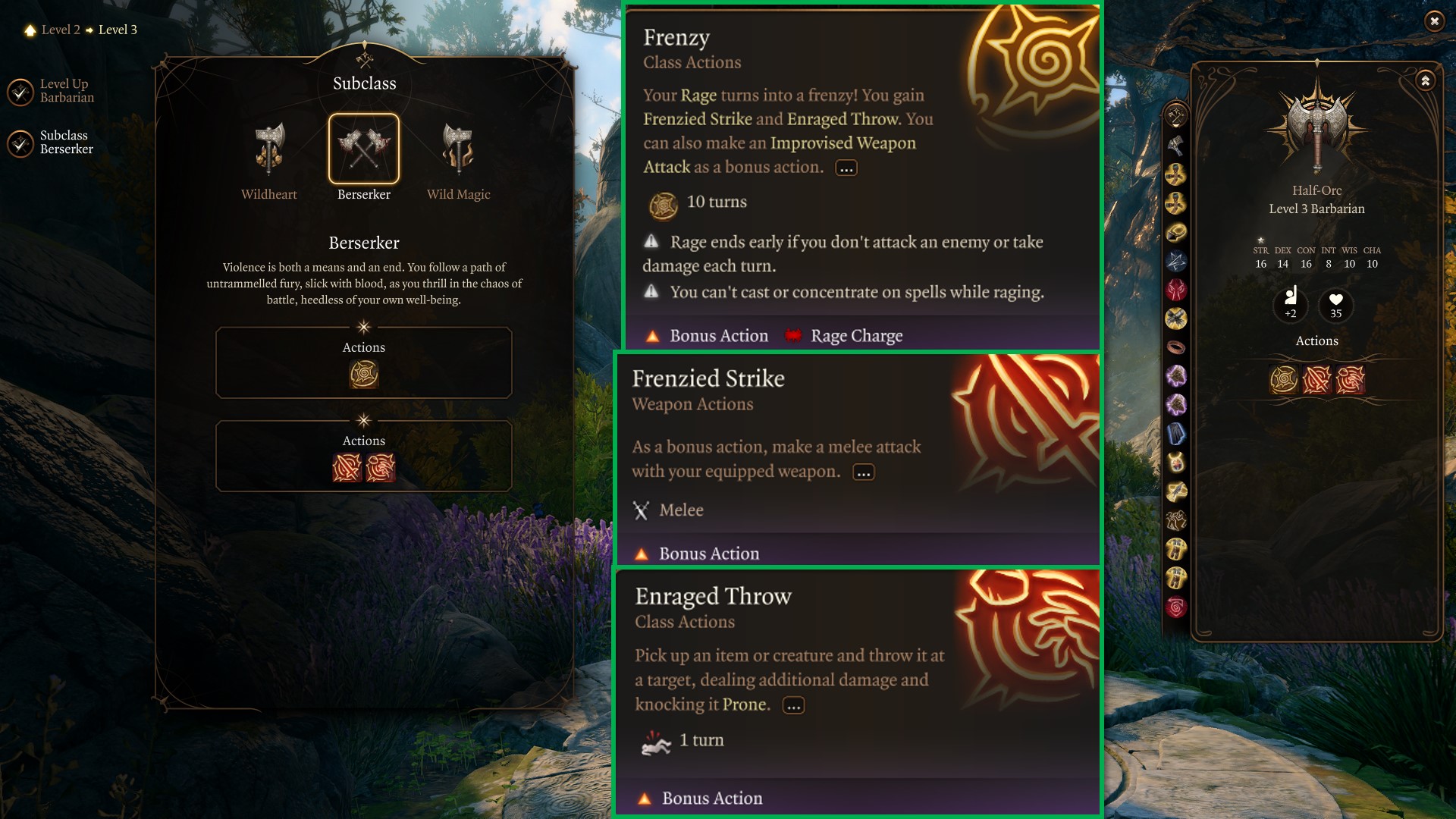
The Honour Mode Barbarian build focuses on high health for survivability and melee aggressive with throw for ranged damage. Below is a sample template of the Honour Mode Barbarian:
- Class: Barbarian
- Subclass: Berserker
- Primary Weapon: Greatsword (Sword of Justice & Balduran Greatsword)
- Secondary: Heavy Crossbow (Darkfire Shortbow)
- Armor: Clothing
- Focus: Melee damage with throw for range
- Consumable: Elixir of Bloodlust or Elixir of Hill Giant Strength
- Key Features: Extra Attack, Frenzy, Great Weapon Master
- Multiclass: 5 Barbarian/Berserker, 4 Rogue/Thief, 3 Fighter/Champion
The Barbarian per-turn damage is incredible, especially with a high-health pool. The game is littered with gear sets for the Barbarian including powerful weapons and clothing designed for the class. The Barbarian starts slow due to mobility but later makes up for it especially if you take Illithid Powers.
Honour Mode Fighter
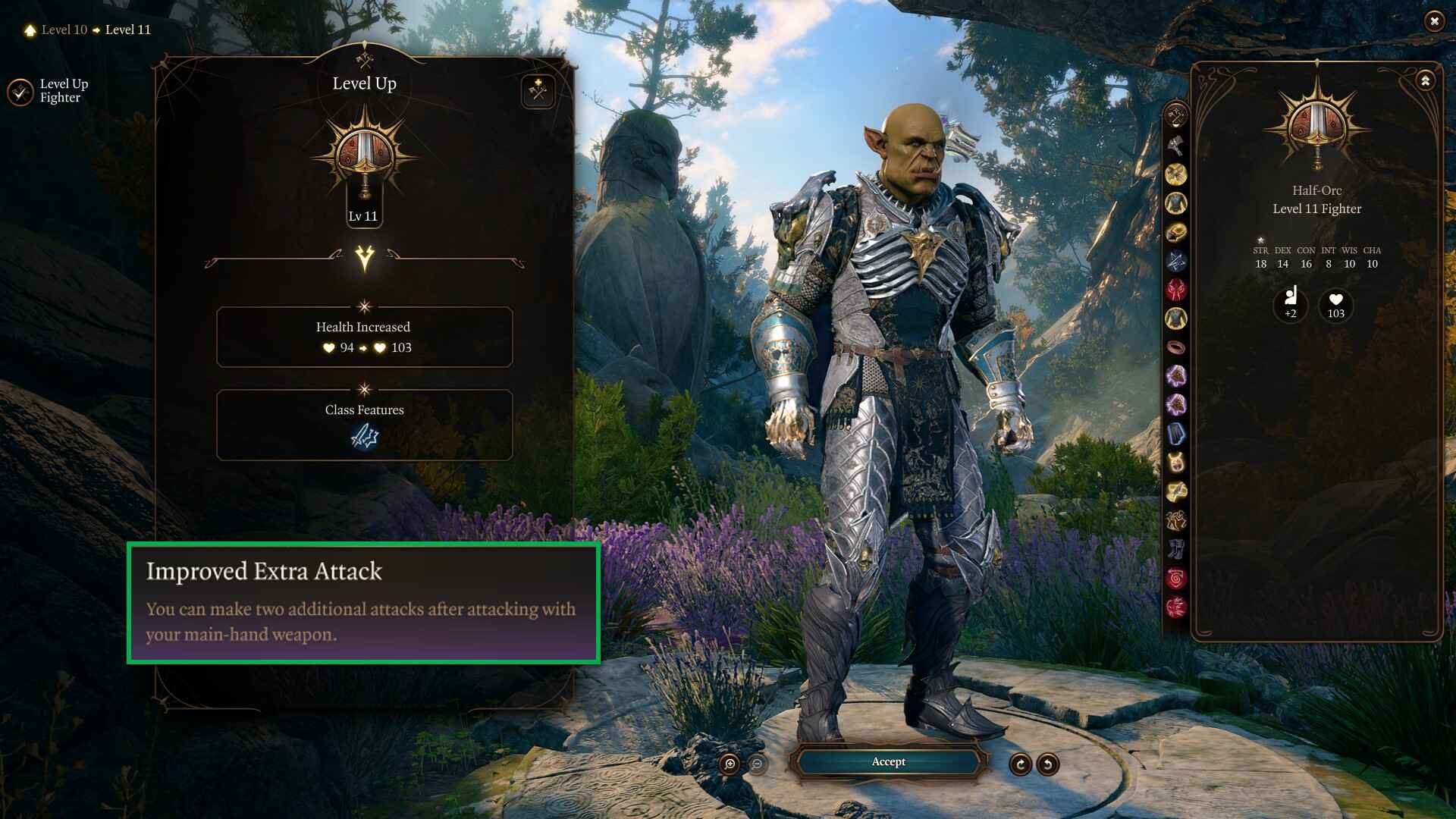
The Honour Mode Fighter emphasizes simplistic and crowd control with Improved Extra Attack for melee damage. Below is a sample template of the Honour Mode Fighter:
- Class: Fighter
- Subclass: Battle Master
- Primary Weapon: Greatsword (Sword of Justice & Balduran Greatsword)
- Secondary: Heavy Crossbow (Darkfire Shortbow)
- Armor: Heavy
- Focus: Melee aggressive
- Consumable: Elixir of Bloodlust or Elixir of Hill Giant Strength
- Key Features: Improved Extra Attack, Action Surge
- Multiclass: No
The Fighter is simple and incredibly effective having unmatched per-action attacks. You gain Improved Extra Attack, which gives you 3 attacks per action. BG3 incentives Greatsword two-handed gameplay and is filled with powerful heavy armour to make you survivable with damage.
Best Honour Mode Party Composition
The best honour mode party composition uses a Multiclass Ranger, Necromancy Wizard, Battle Master Fighter, and Life Cleric. This group composition gives you a variety of damage types, utility spells, crowd control, and raw damage. Below, we explain each party’s role and how to best use them.
Ranger

The main role of the ranger is to initiate combat as a Gloom Stalker to get an Ambush attack bonus. Moreover, the Ranger can combine Oil of Combustion, Arrow of Many targets, and Extra Attack for huge kills. In your first attack you use Arrow of Many targets while Oil of Combustion is active. Then, hit one target with a Fire Arrow or smoke bomb and wipe out the entire group. For single-target fights, there are specific arrows and ammunition for enemies, making the ranger the highest damage dealer. Moreover, you want to equip the Ranger with a Shield and Sword, which can increase passively with AC to 24 or higher at the end game. The only downside is the Ranger lacks the outside-of-combat utility of the Rogue and Thief but makes up for it in overall kill potential.
Battle Master Fighter
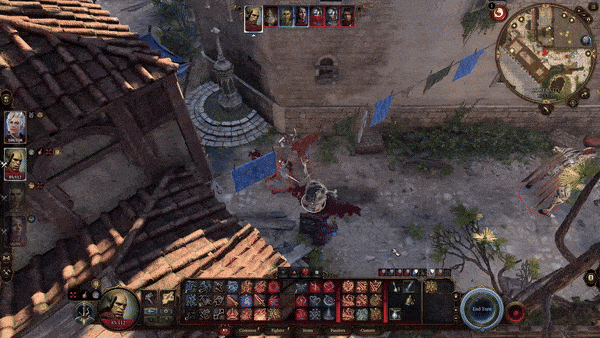
The Battle Master Fighter is meant to be a front damage dealer using two-handed weapons and strength. The benefit of this build is, you can lower Dexerity to 10, and take 4 feats. Increase your strength to 20 while taking Great Weapon Master and Alert. With the Alert feat, you will go very early in combat order and, like the Ranger, take out multiple targets in one turn. The Fighter in Honour Mode focuses more on single-target pressure and using maneuvers to stun and disarm enemies.
Life Cleric

The Life Cleric build is all about buffs, healing, and crowd control. Use spells like bless, sanctuary, death ward, and others to optimize your team. Moreover, Banishment, Command, and Turn Undead are perfect crowd control spells and utility. Lastly, using Planar Ally and Spiritual Weapon at high levels gives your party distraction summons that can deal a bit of damage.
Necromancy Wizard
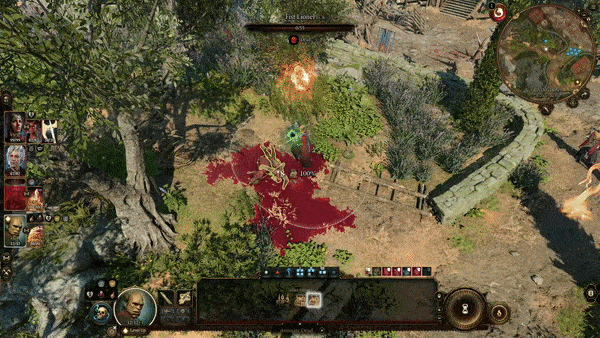
The Necromancy Wizard is perfect for Honour Mode because it has a wide range of versatile spells. The Wizard can learn any spell through scrolls and pre-buff the party. Moreover, the Wizard can prepare spells, thus you can customize your loadout for specific fight needs. This includes lighting damage for constructions, Hold Monster for hard boss fights, and or crowd control when needed. While not the highest damage dealer, the Necromancy Wizard serves as the jack-of-all-trades spell caster.
Permanent Bonuses
To maintain maximum combat power in Baldur’s Gate 3 Honour Mode, you need to acquire all important permanent bonuses. We have a detailed guide on all the permanent bonuses per act, but here’s a summary:
Act 1
- Auntie Ethel’s Hair – Gain +1 to an Ability Score.
- Awakened – Use illithid powers as a Bonus Action.
- Find Familiar: Scratch – Gain Find Familiar Scratch.
- Find Familiar: Cheeky Quasit – Gain Summon Quasit Shovel.
- Loviatar’s Love – 30% Hit Points or less, you gain a +2 bonus to Attack Rolls and Wisdom saving throws.
- Necromancy Of Thay – Gain Speak with Dead.
Act 2
- Potion of Everlasting Vigour – Gain +2 Strength.
- Summon Us – Allows you to summon Us.
Act 3
- Danse Macabre – Create 4 ghouls summons.
- Mirror of Loss – +2 to an Ability Score of your choice.
- Sweet Stone Features – Blessed permanent.
- The Tharchiate Codex: Blessing – Gain 20 temporary hit points after a long rest.
- Statue of the Gods – +2 to Saving Throws
Honour Mode Changes in Patch 7 for BG3
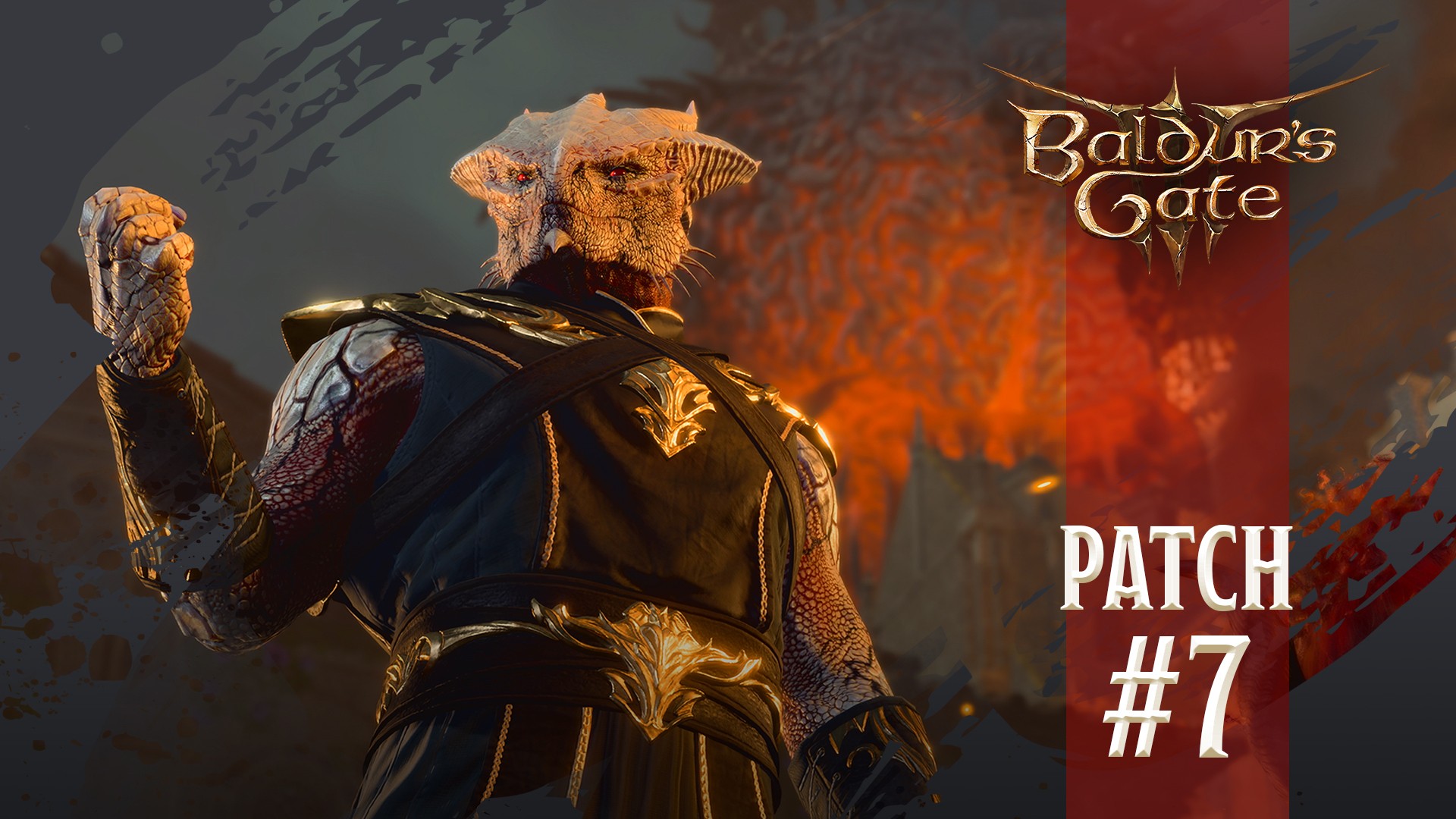
Patch 7 sees a few tweaks to Honour Mode, including a new legendary action for an Act 2. However, combat and gameplay remain untouched with individual builds and companions. Here are the biggest changes to Honour mode in BG3:
- Increased the HP that the Undead Nurses resurrect at from 25% to 45% during the combat with Malus Thorm in Tactician and Honour Mode.
- Improved the Thisobald Thorm combat in Honour Mode:
- Fixed his Legendary Action explosion hitting itself.
- Increased the damage and radius of his Legendary Action explosion.
- His Legendary Action explosion now applies a debuff based on the explosion type.
- Increased the damage of the buff given to his blighted allies.
- Blacked Out no longer applies Vulnerability to all damage in Honour Mode.
- Fixed the Custom Mode banner (that shows up on the left with the Custom Mode artwork, name, and description on it) not showing up if you start a game in Custom Mode with the Honour Ruleset.
- Custom Mode savegames using the Honour Mode ruleset will now be named correctly (instead of suggesting they’re pure Honour savegames).
FAQs about Honour Mode in BG3
Q1: What do you get for beating honor mode in BG3?
Answer: Successfully completing an Honour Mode run will reward you with an in-game Golden D20 skin and the Foehammer Achievement. Enjoy your bragging rights!
Q2: Has anyone completed Honour mode in BG3?
Answer: Yes, many players have completed BG3’s Honour mode, including myself, other streamers, speedrunners, and even regular players like yourself. We highly recommend that you do not play the game in Honour mode on your first try. Play in a lower difficulty level first to enjoy the story of BG3 and learn the mechanics. An Honour mode run is great for a second or third playthrough.
Q3: How many people have beaten the Honour mode in BG3?
Answer: In August of 2024, the developers at Larian Studios revealed that only 10% of players have beaten Honour Mode in Baldur’s Gate 3. Specifically, at that time 141,660 players had finished Honour Mode with zero party deaths, but over 1.2 million fans failed.
Q4: Is Honour mode too easy Baldur’s Gate 3?
Answer: Honour mode it not at all easy in Baldur’s Gate 3, because it is easy to fail a run with a single party wipeout. This could happen early on in Act 1, or very deep into the game in Act 3. It takes careful strategy, crafted builds, and some luck.
Looking For More About Baldur’s Gate 3?
Thank you for reading the Baldur’s Gate 3: Honour Mode Guide. We provide the latest news and create guides for Baldur’s Gate 3. Also, watch me play games on Twitch or visit my YouTube channel!
 Reddit
Reddit
 Email
Email
